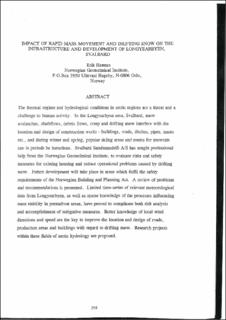| dc.description.abstract | The thermal regime and hydrological conditions in arctic regions are a threat and a challenge to human activity. In the Longyearbyen area, Svalbard, snow avalanches, slushflows, debris flows , creep and drifting snow interfere with the location and design of construction works - buildings, roads, ditches, pipes, masts etc., and during winter and spring, popular skiing areas and routes for snowcats can in periods be hazardous. Svalbard Samfunnsdrift AIS has sought professional help from the Norwegian Geotechnical Institute, to evaluate risks and safety measures for existing housing and reduce operational problems caused by drifting snow. Future development will take place in areas which fulfill the safety requirements of the Norwegian Building and Planning Act. A review of problems and recommendations is presented. Limited time-series of relevant meteorological data from Longyearbyen, as weIl as sparse knowledge of the processes influencing mass stability in permafrost areas, have proved to complicate both risk analysis and accomplishment of mitigative measures. Better knowledge of local wind direction and speed are the key to improve the location and design of roads, production areas and buildings with regard to drifting snow. Research projects within these fields of arctic hydrology are proposed. | en_US |
